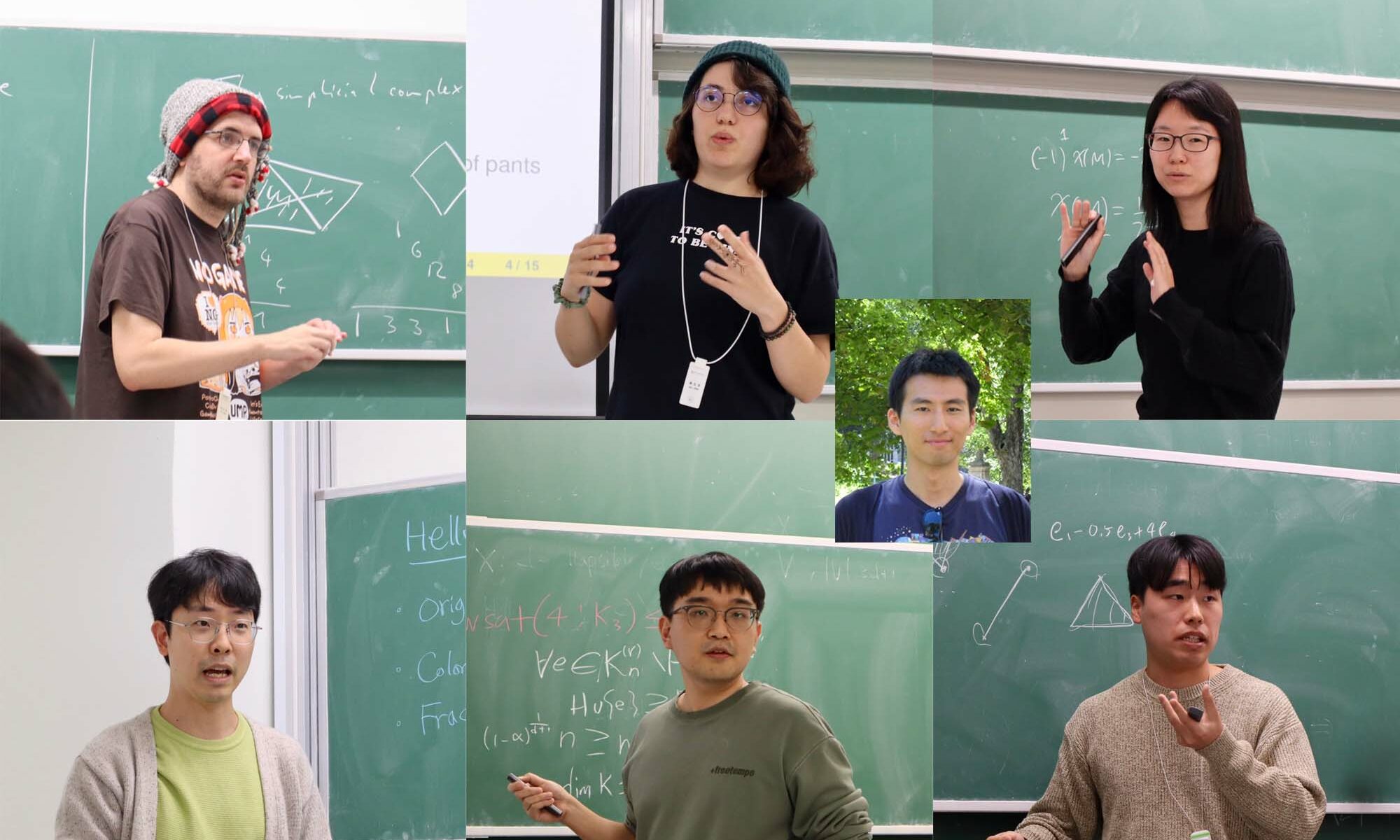The IBS-DIMAG Workshop on Topology and Combinatorics will be held on November 11, 2024 at Room B332, Institute for Basic Science (IBS), Daejeon, South Korea.
Invited Speakers (tentative)
Tentative Schedule
- 11:00-11:30 Karim Adiprasito, The Charney Davis conjecture and Boolean decompositions
- 12:00-14:00 Lunch Break
- 14:00-14:30 Niloufar Fuladi, Universal families of arcs and curves on surfaces
- 14:30-15:00 Semin Yoo유세민, The Charney-Davis conjecture and its related complexes (survey)
- 15:00-15:30 Geunho Lim임근호, Bounds on Cheeger-Gromov invariants and simplicial complexity of triangulated manifolds
- 15:30-16:00 Break
- 16:00-16:30 Minki Kim김민기, Some extensions of the colorful Helly theorem
- 16:30-17:00 Minho Cho조민호, Fractional Helly theorems via weak saturation
- 17:00-17:30 Dohyeon Lee이도현, Betti number of clique complex of H-free graphs (survey)
- 18:00-20:00 Banquet
Organizer
Abstracts
Karim Adiprasito, The Charney Davis conjecture and Boolean decompositions
I will present a novel approach to the Charney Davis conjecture by introducing anticommutative Lefschetz properties, and studying them on the Danzer complex of flag spheres.
Semin Yoo, The Charney-Davis conjecture and its related complexes (survey)
The Charney-Davis conjecture lies in the intersection between topology and combinatorics. The conjecture is a special case of the Hopf-Chern-Thurston conjecture for all nonpositively curved, piecewise Euclidean manifolds which are cellulated by regular Euclidean cubes. In 2001, Davis and Okun solved the conjecture for a 4-dimensional case, and some other partial results are also known. However, the conjecture is still open so far.
In this talk, I will describe five statements that solve the Charney-Davis conjecture and explain some complexes to achieve this goal.
Niloufar Fuladi, Universal families of arcs and curves on surfaces
In this talk I introduce a family of curves that realize all pants decomposition of a surface: a family of simple closed curves Γ on a surface realizes all types of pants decompositions if for any pants decomposition of the surface, there exists a homeomorphism sending it to a subset of the curves in Γ. The study of such universal families of curves is motivated by questions on graph embeddings, joint crossing numbers and finding an elusive center of moduli space. I will discuss the case of surfaces without punctures, where we establish an exponential upper bound and a superlinear lower bound on the minimum size of the family of curves with this universal property. I also talk about a similar concept of universality for triangulations of polygons, where we provide bounds which are tight up to logarithmic factors. In this talk, I will explain the background and context and no prior knowledge in topology or surfaces is needed.
This is joint work with Arnaud de Mesmay and Hugo Parlier.
Geunho Lim, Bounds on Cheeger-Gromov invariants and simplicial complexity of triangulated manifolds
Using L^2 cohomology, Cheeger and Gromov define the L^2 rho-invariant on manifolds with arbitrary fundamental groups, as a generalization of the Atiyah-Singer rho-invariant. There are many interesting applications in geometry, topology, and combinatorics. In this talk, we show linear bounds on the rho-invariants in terms of simplicial complexity of manifolds by using hyperbolization methods. As applications, we give new concrete examples in the complexity theory of high-dimensional (homotopy) lens spaces. This is a joint work with Shmuel Weinberger.
Minki Kim, Some extensions of the colorful Helly theorem
Given $k > d$ finite families of convex sets in $\mathbb{R}^d$, if every colorful $(d+1)$-tuple is intersecting, then the union of $k-d$ color classes is intersecting. This is known as the colorful Helly theorem. Based on recent joint work with Alan Lew, I will present some extensions of the colorful Helly theorem and their applications.
Minho Cho, Fractional Helly theorems via weak saturation
Two celebrated extensions of the classical Helly’s theorem are the fractional Helly theorem and the colorful Helly theorem. Bulavka, Goodarzi, and Tancer recently established the optimal bound for the unified generalization of the fractional and the colorful Helly theorems using a colored extension of the exterior algebra. In this talk, we introduce a combinatorial reduction of both the fractional Helly theorem and its colorful version to a classical problem in extremal combinatorics known as weak saturation. No such results connecting the fractional Helly theorem and weak saturation are known in the long history of literature. These reductions, along with basic linear algebraic arguments for the reduced weak saturation problems, let us give new short proofs of the optimal bounds for both the fractional Helly theorem and its colorful version without using exterior algebra.
This is joint work with Debsoumya Chakraborti, Jinha Kim, and Minki Kim.
Dohyeon Lee, Betti number of clique complex of H-free graphs (survey)
The clique complex of a graph is a simplicial complex whose faces correspond to cliques of the given graph. In this talk, we investigate extremal properties of the Betti numbers of clique complexes. While general simplicial complexes with n vertices can have a total Betti number approximately $2^n$, Adamaszek showed that Betti number of clique complex is bounded by around $1.32^n$. Furthermore, if the underlying graph has an independence number at most two, the bound tightens to $1.25^n$. Adiprasito, Nevo, and Tancer established additional bounds on the total Betti number for clique complexes of (induced) H-free graphs for various graph H, along with constructions of graphs with large total Betti number. In another direction, Zhang and Wu demonstrated that for ternary graphs (whose with no induced cycles of length 3n), the Betti number of the independence complex (the clique complex of the complement of a graph) is at most one. Indeed, Jinha Kim showed that these independence complexes are either contractible or homotopy spheres.


